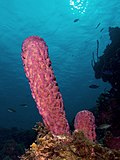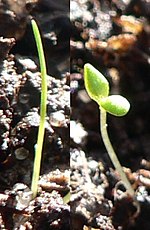Cryptochromes (from the Greek κρυπτός χρώμα, "hidden colour") are a class of flavoproteins found in plants and animals that are sensitive to blue light...
59 KB (6,466 words) - 19:20, 30 July 2024
Magnetoreception (section Cryptochrome)
Experiments on migratory birds provide evidence that they make use of a cryptochrome protein in the eye, relying on the quantum radical pair mechanism to...
59 KB (6,208 words) - 05:28, 7 August 2024
Earth. In 2000, cryptochrome was proposed as the "magnetic molecule" that could harbor magnetically sensitive radical-pairs. Cryptochrome, a flavoprotein...
73 KB (8,032 words) - 13:35, 2 June 2024
night. Cryptochromes are another type of photoreceptor that is important in photoperiodism. Cryptochromes absorb blue light and UV-A. Cryptochromes entrain...
22 KB (2,676 words) - 04:39, 22 August 2024
clocks in 1990. In 1998, they discovered the cycle gene, clock gene, and cryptochrome photoreceptor in Drosophila through the use of forward genetics, by first...
26 KB (2,781 words) - 23:02, 16 July 2024
Denzau S, Malkemper EP, Gross JC, Burda H, Winklhofer M, et al. (2016). "Cryptochrome 1 in Retinal Cone Photoreceptors Suggests a Novel Functional Role in...
167 KB (15,766 words) - 04:06, 26 August 2024
Carla Green (section Cryptochrome)
lean mice; and defining structural components of the repressor protein Cryptochrome and how regulation of the nuclear entry of the protein contributes to...
20 KB (2,164 words) - 17:16, 3 December 2023
Circasemidian rhythm Circaseptan, 7-day biological cycle Cryptochrome CRY1 and CRY2: the cryptochrome family genes Diurnal cycle Light effects on circadian...
110 KB (12,913 words) - 09:01, 24 August 2024
Anthony Cashmore (section Cryptochrome)
biochemist and plant molecular biologist, best known for identifying cryptochrome photoreceptor proteins. These specialized proteins are critical for plant...
34 KB (3,223 words) - 10:46, 2 May 2024
initial assumptions that they were cryptochromes. Eukaryotic (6-4)DNA photolyases form a group with animal cryptochromes that control circadian rhythms....
15 KB (1,747 words) - 14:50, 5 August 2024
from phytochromes and cryptochromes allow the plant to respond to various kinds of light. Together phytochromes and cryptochromes inhibit gravitropism...
17 KB (2,027 words) - 18:50, 4 April 2024
flowering time, photosynthesis, biomass accumulation, activation of cryptochrome, and shoot growth. As an adaptive behavior, magnetotropism is recognizing...
6 KB (706 words) - 18:51, 9 May 2024
light-induced reactions in cryptochrome are consistent with its proposed role as a magnetoreceptor Chemical Magnetoreception: Bird Cryptochrome 1a Is Excited by...
7 KB (732 words) - 21:17, 26 January 2024
strongly. Humans have, including rhodopsin, nine opsins, as well as cryptochrome (light-sensitive, but not an opsin). Rhodopsin, like other opsins, is...
39 KB (4,414 words) - 06:40, 23 May 2024
Sancar and his research team have discovered that two genes, Period and Cryptochrome, keep the circadian clocks of all human cells in proper rhythm, syncing...
27 KB (2,457 words) - 15:21, 27 July 2024
photoreceptors: phytochrome, cryptochrome, a UV-B photoreceptor, and protochlorophyllide a. The first two of these, phytochrome and cryptochrome, are photoreceptor...
30 KB (3,553 words) - 20:52, 18 May 2024
to far-red light which occurs when the shoot comes out into the open. Cryptochrome 1 responds to increasing amounts of blue light when the shoot reaches...
5 KB (592 words) - 23:25, 23 June 2024
the presence or amount of moonlight. Corals contain light-sensitive cryptochromes, proteins that are sensitive to different levels of light. Coral species...
43 KB (4,871 words) - 08:26, 27 August 2024
Benjamin P.; Green, Carla B. (2013-12-06). "Phosphorylation of the cryptochrome 1 C-terminal tail regulates circadian period length". The Journal of...
39 KB (4,432 words) - 07:12, 13 February 2024
photosynthesis where light is used as a source of energy. Phytochromes, cryptochromes, and phototropins are photochromic sensory receptors that restrict the...
16 KB (1,934 words) - 22:37, 14 April 2024
equations of motion (HEOM) approach, which have been applied to plant cryptochromes and bacteria light-harvesting complexes, respectively. Both quantum...
101 KB (11,357 words) - 21:37, 30 July 2024
ostia. Many larval sponges possess neuron-less eyes that are based on cryptochromes. They mediate phototaxic behavior. Glass sponges present a distinctive...
129 KB (13,202 words) - 07:56, 25 August 2024
while high energy radiations are accepted by carotenoids, flavins, cryptochromes in addition to phytochromes. The photomorphogenic process of phytochrome-mediated...
35 KB (3,303 words) - 16:40, 16 August 2024
of photoreceptor pigments include: retinal (in rhodopsin) flavin (in cryptochrome) bilin (in phytochrome) In medical terminology, the term photopigment...
3 KB (328 words) - 02:33, 16 July 2021
through the light receptors phytochrome (red and far-red light) and cryptochrome (blue light). Mutations in these photo receptors and their signal transduction...
11 KB (1,384 words) - 09:15, 17 October 2023
crypt, cryptanalysis, crypteia, cryptic, cryptobiosis, cryptobiotic, cryptochrome, cryptogam, cryptogenic, cryptography, cryptology, cryptomonad, cryptophyte...
1 KB (1,500 words) - 06:14, 16 April 2024
Phototropins can be found throughout the leaves of a plant. Along with cryptochromes and phytochromes they allow plants to respond and alter their growth...
9 KB (1,031 words) - 01:59, 20 June 2024
absorbs maximally violet light (450 nm). The opsin Rh7 entrains with cryptochrome the circadian rhythm of Drosophila to the day-night-cycle in the central...
145 KB (16,685 words) - 04:50, 26 August 2024
females in angular preferences were found. Some studies have detected cryptochrome 1 in some dogs' photoreceptors' blue-sensitive cones. Primarily, dogs...
55 KB (6,712 words) - 18:54, 31 July 2024
in the upper beak for magnetoreception, which (in conjunction with cryptochromes in the retina) gives them the ability to sense the direction, polarity...
51 KB (5,368 words) - 10:16, 2 July 2024





















